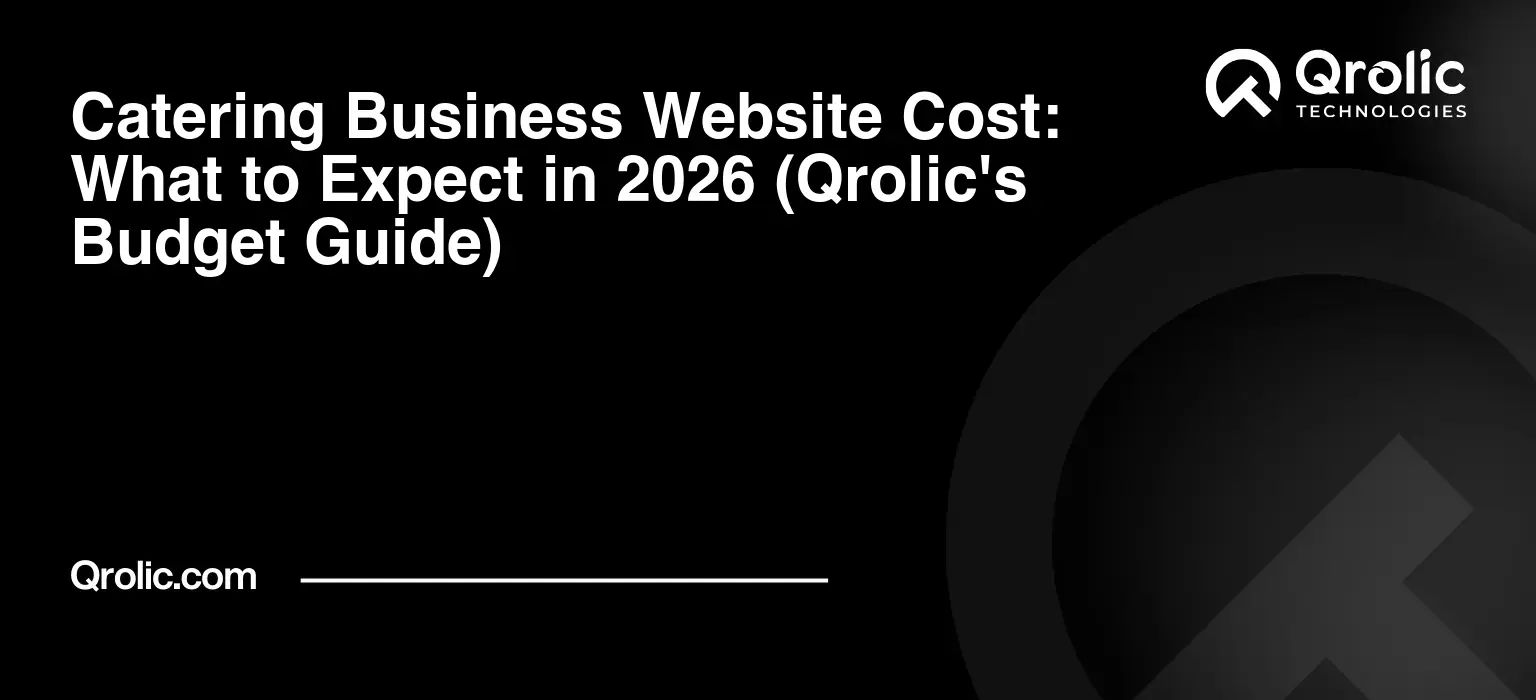Quick Summary:
- A professional website is crucial for catering success in 2026.
- Website costs vary widely, from DIY to custom solutions.
- Budget for ongoing maintenance, updates, and marketing efforts.
- Strategic planning and professional help maximize your investment.
Table of Contents
- Understanding the “Why”: The Indispensable Role of a Catering Website in 2026
- Beyond a Digital Brochure: The Modern Catering Website
- Why Invest Now? The ROI of a Professional Catering Website
- 1. Credibility and Trust
- 2. Reach and Visibility
- 3. Streamlined Operations and Efficiency
- 4. Competitive Edge
- 5. Future-Proofing Your Business
- Deconstructing the “What”: Core Components Influencing Catering Website Cost
- A. Domain Name & Hosting: The Foundation
- 1. Domain Name Selection and Annual Cost
- 2. Website Hosting Types and Pricing
- B. Website Design and Development: The Visual & Functional Heart
- 1. DIY Website Builders (e.g., Squarespace, Wix, wordpress.com): Pros, Cons, Costs
- 2. Template-Based Websites (WordPress.org with Themes): Flexibility and Cost
- 3. Custom-Designed Websites: The Bespoke Experience and Premium Cost
- C. Essential Features for a Catering Website: What You Absolutely Need
- 1. Responsive Design (Mobile-First Approach)
- 2. High-Quality Photography and Videography
- 3. Menu Presentation & Customization Options
- 4. Online Ordering & Booking System (Reservations, Quotes, Payments)
- 5. Contact Forms & Inquiry Management
- 6. Testimonials & Client Portfolios
- 7. Blog/Content Management System (CMS)
- 8. About Us / Our Story Page
- 9. Social Media Integration
- 10. GDPR/Privacy Policy Compliance
- D. Advanced Features (Optional but Impactful)
- 1. CRM Integration
- 2. Live Chat Functionality
- 3. Advanced SEO Features
- 4. Loyalty Programs
- 5. Virtual Tours/360-Degree Views of Venues/Dishes
- 6. Event Planning Tools & Calculators
- The “How Much”: A Detailed Breakdown of Catering Website Cost Ranges (2026 Projections)
- A. Tier 1: The Budget-Friendly Approach (DIY/Basic Template)
- 1. Expected Features
- 2. Cost Range (2026)
- 3. Who it’s For
- B. Tier 2: The Mid-Range Professional Website (Customized Template/Small Agency)
- 1. Expected Features
- 2. Cost Range (2026)
- 3. Who it’s For
- C. Tier 3: The Premium, Custom-Built Website (Full-Service Agency/Enterprise Solution)
- 1. Expected Features
- 2. Cost Range (2026)
- 3. Who it’s For
- D. Hidden Costs and Ongoing Expenses to Anticipate
- 1. Website Maintenance & Security
- 2. Content Updates & Management
- 3. Software Licenses & Plugin Subscriptions
- 4. SSL Certificates (if not included)
- 5. Marketing & SEO (Post-Launch)
- 6. Payment Gateway Fees
- 7. Professional Photography/Videography Updates
- Maximizing Your Investment: Strategies for an Affordable Yet Powerful Catering Website
- A. Clear Planning & Goal Setting
- B. Prioritizing Features: Needs vs. Wants
- C. Smart Content Strategy: DIY vs. Professional
- D. Phased Development: Launching an MVP (Minimum Viable Product)
- E. Negotiating with Developers/Agencies
- F. Leveraging Open-Source Solutions (where appropriate)
- G. Understanding Maintenance Packages
- The “When” and “How”: The Development Process for Your Catering Website
- A. Phase 1: Discovery & Planning
- B. Phase 2: Design & Wireframing
- C. Phase 3: Development & Coding
- D. Phase 4: Content Integration & SEO Setup
- E. Phase 5: Testing & Launch
- F. Phase 6: Post-Launch Support & Marketing
- Qrolic Technologies: Your Partner in Crafting an Exceptional Catering Website
- A. Who We Are and Our Vision
- B. Our Expertise in the Food & Beverage Industry
- C. How Qrolic Delivers Value for Your Catering Business
- 1. Custom Solutions Tailored to Your Brand
- 2. Focus on ROI and Business Growth
- 3. Comprehensive Service Offering (Design, Development, SEO, Maintenance)
- 4. Transparent Pricing and Budgeting
- D. Getting Started with Qrolic: A Simple Process
- Case Studies & Success Stories (Illustrative Examples)
- A. From Zero to Hero: A Small Caterer’s Journey (Tier 1 to Tier 2 Evolution)
- B. Scaling Up: How a Mid-Sized Caterer Expanded Reach (Tier 2 to Tier 3)
- C. The Premium Experience: A Luxury Caterer’s Digital Transformation (Tier 3)
- Key Takeaways & Final Thoughts on Your Catering Website Investment
- A. Your Website as a Living Asset
- B. The Value of Expertise (Professional Help)
- C. Planning for the Future
Understanding the “Why”: The Indispensable Role of a Catering Website in 2026

The aroma of freshly baked bread, the vibrant colors of a gourmet salad, the clink of glasses at a celebratory event – these are the sensory delights that define your catering business. But in the digital age of 2026, how do potential clients discover these delights? How do they connect with your passion and professionalism? The answer, unequivocally, lies in a powerful, engaging, and highly functional website. Gone are the days when a simple social media presence sufficed. For a catering business, a dedicated website isn’t just an accessory; it’s the beating heart of your digital presence and a non-negotiable asset for growth.
Beyond a Digital Brochure: The Modern Catering Website
Imagine your website not just as a place where you list your services, but as a virtual maître d’, a dynamic portfolio, an efficient booking agent, and a compelling storyteller, all rolled into one. In 2026, a catering business website is a sophisticated ecosystem designed to:
- Showcase your artistry: High-resolution images and videos of your culinary creations and event setups speak volumes.
- Communicate your unique brand story: What makes your catering service special? Your website is the perfect platform to share your ethos, values, and the passion behind every dish.
- Streamline customer interactions: From initial inquiry to final booking, a well-designed site simplifies the entire customer journey.
- Generate qualified leads: Optimized content and clear calls to action guide interested visitors towards becoming paying clients.
- Provide a seamless user experience: Easy navigation, mobile responsiveness, and fast loading times are crucial for capturing and retaining attention.
Why Invest Now? The ROI of a Professional Catering Website
The question isn’t if you need a website, but how much to invest in one that truly reflects your brand and drives revenue. The return on investment (ROI) for a professional catering website in 2026 is multifaceted and substantial, far outweighing the initial catering business website cost.
1. Credibility and Trust
In an increasingly crowded market, a professional website instantly elevates your credibility. It signals to potential clients that you are a serious, legitimate business. A sleek design, clear information, and secure online processes build trust even before the first conversation. Conversely, a poor or absent website can sow seeds of doubt, making potential customers question your professionalism and reliability.
2. Reach and Visibility
Your physical catering kitchen might be in one city, but your website has the power to reach clients across an entire region, or even globally, for destination events. Through search engine optimization (SEO), your website can appear prominently when people search for “catering services near me,” “event catering [city name],” or “corporate catering solutions.” This expanded reach translates directly into more inquiries and potential bookings.
3. Streamlined Operations and Efficiency
Imagine eliminating endless phone calls for menu inquiries or availability checks. A well-structured catering website can host detailed menus, FAQs, online booking forms, and even pricing guides. This automation frees up your valuable time, allowing you and your team to focus on what you do best: crafting unforgettable culinary experiences. It also reduces human error and ensures consistent information delivery.
4. Competitive Edge
While many caterers have websites, not all are created equal. A superior website – one that is fast, beautiful, functional, and user-friendly – immediately sets you apart from competitors who might have outdated or clunky online presences. It showcases innovation and a commitment to customer service, giving you a distinct advantage.
5. Future-Proofing Your Business
The digital landscape is constantly evolving. A robust website built on a flexible platform allows for future expansion, integration of new technologies (like AI-driven personalization or virtual reality tours), and adaptation to changing market demands. It’s an investment not just for today, but for the sustained growth and relevance of your catering business for years to come.
Deconstructing the “What”: Core Components Influencing Catering Website Cost
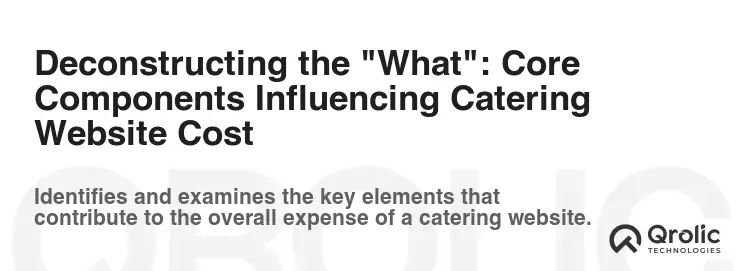
Understanding the various elements that contribute to the overall catering business website cost is crucial for effective budgeting. Think of it like planning a complex event: you itemize everything from venue to catering, decorations to entertainment. Your website development is no different.
A. Domain Name & Hosting: The Foundation
Every great catering website needs a place to live and an address for people to find it. These are your domain name and web hosting.
1. Domain Name Selection and Annual Cost
Your domain name is your website’s unique address (e.g., yourcateringco.com). It should be memorable, easy to spell, and reflective of your brand.
- Cost Expectation (2026): Typically ranges from $10 – $25 per year. Premium domain names (short, highly desirable keywords) can cost significantly more, sometimes thousands of dollars, but this is rare for most caterers.
- Tip: Choose a
.comextension if possible, as it’s the most recognized. Consider local extensions like.co.ukor.caif your target audience is geographically specific.
2. Website Hosting Types and Pricing
Web hosting is the service that stores your website’s files and makes them accessible on the internet. The type of hosting directly impacts your site’s speed, security, and scalability, all of which influence the website cost for caterers.
- Shared Hosting: Most affordable. Your website shares server resources with many other sites.
- Cost Expectation (2026): $5 – $20 per month (often cheaper with annual plans).
- Best For: Small catering businesses, startups, or those with very low traffic expectations.
- VPS (Virtual Private Server) Hosting: More resources and better performance than shared hosting. You get dedicated server space within a shared physical server.
- Cost Expectation (2026): $20 – $80 per month.
- Best For: Growing catering businesses needing better performance, handling moderate traffic, or requiring more control.
- Dedicated Hosting: You get an entire physical server just for your website. Maximum performance and control.
- Cost Expectation (2026): $80 – $300+ per month.
- Best For: Large catering enterprises, high-traffic sites, or those with complex custom applications.
- Cloud Hosting: Highly scalable and flexible. Your website is hosted on a network of virtual servers, allowing resources to be scaled up or down as needed.
- Cost Expectation (2026): $30 – $150+ per month (often pay-as-you-go).
- Best For: Catering businesses with fluctuating traffic, seasonal peaks, or those prioritizing scalability.
B. Website Design and Development: The Visual & Functional Heart
This is often the largest component of your how much does a catering website cost. It encompasses everything from the look and feel (design) to the underlying code and functionality (development).
1. DIY Website Builders (e.g., Squarespace, Wix, wordpress.com): Pros, Cons, Costs
These platforms offer drag-and-drop interfaces, making it possible for individuals with no coding experience to build a basic website.
- Pros: Extremely low initial cost, fast setup, user-friendly, includes hosting and basic templates.
- Cons: Limited customization, often less robust SEO capabilities, you don’t own the underlying code, can be difficult to migrate later, may not scale well for complex features.
- Cost Expectation (2026): $15 – $50 per month (billed annually), plus potential costs for premium templates or apps. Total annual cost can be $180 – $600+.
- Best For: Startups on a shoestring budget, caterers needing a very basic online presence quickly, or those testing a concept.
2. Template-Based Websites (WordPress.org with Themes): Flexibility and Cost
This involves using a content management system (CMS) like WordPress.org (the self-hosted version) combined with a pre-designed theme. You’ll need separate hosting.
- Pros: Highly flexible, vast ecosystem of plugins for added functionality (online ordering, galleries), good for SEO, scalable, you own your website files.
- Cons: Requires a bit more technical know-how than DIY builders (or the help of a developer), ongoing maintenance is necessary.
- Cost Expectation (2026):
- Theme: Free to $100 – $200 (one-time) for premium themes.
- Plugins: Many are free, but premium ones can be $20 – $100 per year each.
- Development/Customization: If you hire someone to set up and customize the theme, expect $1,500 – $5,000+.
- Total Initial Investment: $1,500 – $6,000+ (excluding hosting).
- Best For: Small to medium-sized catering businesses seeking a professional look, good functionality, and room for growth, while managing the catering website budget effectively.
3. Custom-Designed Websites: The Bespoke Experience and Premium Cost
This is where a web design agency or a freelance developer builds your website from scratch, tailored precisely to your brand, vision, and specific functional requirements.
- Pros: Unique design, maximum flexibility and scalability, superior performance, optimized user experience, strong brand identity, built-in advanced SEO features.
- Cons: Highest initial cost to build catering website, longer development time.
- Cost Expectation (2026):
- Freelancer: $5,000 – $15,000+.
- Small Agency: $10,000 – $30,000+.
- Mid-to-Large Agency: $25,000 – $75,000+.
- Best For: Established catering businesses, luxury caterers, those with complex operational needs (e.g., sophisticated online ordering, multi-location management), or businesses with a very strong, distinct brand that requires a truly unique online presence. This is an investment in a powerful digital asset.
C. Essential Features for a Catering Website: What You Absolutely Need
Regardless of your chosen development route, certain features are non-negotiable for an effective catering website. Each feature adds to the overall catering website development cost, but also to its value.
1. Responsive Design (Mobile-First Approach)
With a significant portion of internet traffic coming from mobile devices, your website must look and function perfectly on smartphones and tablets. Google also prioritizes mobile-friendly sites. This is foundational.
2. High-Quality Photography and Videography
Food is visual! Mouth-watering photos of your dishes, elegant event setups, and perhaps even a behind-the-scenes video of your team in action are paramount. This isn’t just a “nice-to-have”; it’s essential for a food business.
- Cost: Professional food photography can range from $500 – $3,000+ per shoot, depending on scope.
3. Menu Presentation & Customization Options
Clearly display your offerings. This might include:
- Downloadable PDF menus.
- Interactive menus with descriptions, allergens, and pricing.
- Options for dietary restrictions (vegetarian, vegan, gluten-free).
- Customizable package builders (e.g., choose a protein, two sides, a dessert).
4. Online Ordering & Booking System (Reservations, Quotes, Payments)
This is a game-changer for efficiency. Clients should be able to:
- Request a quote for an event.
- Check your availability.
- Place orders for corporate lunches or small gatherings.
- Pay deposits or full amounts securely online.
- Cost: This can range from simple form integrations (minimal cost) to complex e-commerce platforms (up to $500 – $5,000+ for setup, plus monthly fees or transaction charges).
5. Contact Forms & Inquiry Management
Easy-to-use forms for general inquiries, specific event requests, and quick questions. Integrate these with a system that helps you manage leads efficiently.
6. Testimonials & Client Portfolios
Social proof is incredibly powerful. Showcase glowing reviews from satisfied clients and a portfolio of past events (with photos and descriptions) to demonstrate your capabilities.
7. Blog/Content Management System (CMS)
A blog is vital for SEO and connecting with your audience. Share recipes, event planning tips, catering trends, or stories behind your seasonal menus. This positions you as an industry expert.
8. About Us / Our Story Page
People connect with people. Share your journey, your team’s passion, and what drives your catering business. This humanizes your brand.
9. Social Media Integration
Link to your Instagram, Facebook, and other relevant platforms. Consider displaying a live feed of your social media posts to keep content fresh.
10. GDPR/Privacy Policy Compliance
Essential for legal compliance and building trust, especially with data handling.
D. Advanced Features (Optional but Impactful)
For those looking to push the boundaries and truly stand out, these features can significantly enhance the user experience and your operational capabilities, though they will increase your catering business website cost.
1. CRM Integration
Connect your website’s inquiry forms directly to a Customer Relationship Management (CRM) system (e.g., HubSpot, Salesforce, Zoho). This streamlines lead management, client communication, and follow-ups.
- Cost: CRM subscriptions vary widely, from free tiers to $50 – $300+ per month, plus integration costs (if not native).
2. Live Chat Functionality
Provide instant support and answer immediate questions, significantly improving customer engagement and conversion rates.
- Cost: Many free options exist, premium versions with more features can be $20 – $100 per month.
3. Advanced SEO Features
Beyond basic on-page SEO, this includes technical SEO audits, schema markup implementation (for rich snippets in search results), local SEO optimization, and ongoing keyword research.
- Cost: Often part of an ongoing SEO package, $500 – $2,000+ per month.
4. Loyalty Programs
Encourage repeat business with integrated loyalty points, discounts, or special offers for returning clients.
5. Virtual Tours/360-Degree Views of Venues/Dishes
If you offer catering at specific venues or have unique presentation styles, virtual tours can provide an immersive experience.
6. Event Planning Tools & Calculators
Tools like a catering cost estimator, portion calculator, or event timeline planner can be incredibly useful resources for clients, enhancing your site’s value.
The “How Much”: A Detailed Breakdown of Catering Website Cost Ranges (2026 Projections)
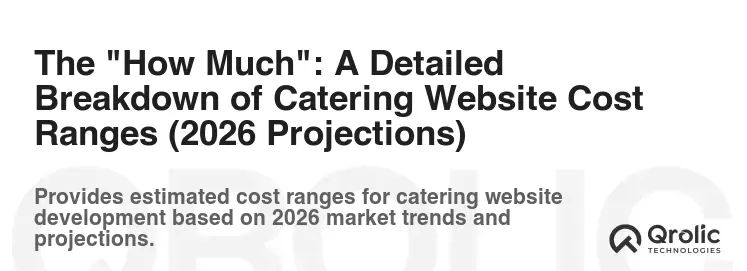
The cost of a catering business website can vary as widely as the types of catering services available, from a simple food truck to a luxury event caterer. It’s not a one-size-fits-all figure. Let’s break down what you can expect across different budget tiers in 2026.
A. Tier 1: The Budget-Friendly Approach (DIY/Basic Template)
This tier is for startups, very small businesses, or those needing an online presence fast without a significant upfront investment.
1. Expected Features
- Basic information pages (Home, About Us, Services, Contact).
- Simple menu display (often as text or PDF download).
- Standard contact form.
- Mobile-responsive design (from the builder’s templates).
- Limited customization options, often using stock photography or basic branding.
- No complex online ordering or booking system beyond a simple inquiry form.
2. Cost Range (2026)
- Domain Name: $10 – $25 per year.
- Website Builder Subscription: $15 – $50 per month ($180 – $600 annually).
- Optional (if not free in plan): Premium template: $0 – $100 (one-time).
- Photography: DIY with a smartphone or free stock photos, or a very basic professional shoot: $0 – $500.
- Total Initial Investment: $200 – $1,200 annually.
- Ongoing Annual Cost: Essentially the annual subscription of the builder + domain.
3. Who it’s For
- New catering ventures testing the market.
- Small-scale caterers with a very local client base.
- Businesses with minimal digital marketing needs or technical resources.
- Those prioritizing speed to market over extensive functionality.
B. Tier 2: The Mid-Range Professional Website (Customized Template/Small Agency)
This is the sweet spot for many growing catering businesses. It offers a balance between professional design, robust functionality, and manageable cost.
1. Expected Features
- Customized theme design reflecting your brand identity.
- Detailed, interactive menus with descriptions and allergen info.
- Professional photo gallery and possibly some video.
- Robust inquiry forms, possibly an integrated calendar for availability checks.
- Basic online ordering or quote request system.
- Blog section for content marketing.
- Testimonials, client portfolio.
- Basic SEO setup.
- Integration with social media and email marketing.
2. Cost Range (2026)
- Domain Name: $10 – $25 per year.
- Hosting (Shared/VPS): $10 – $50 per month ($120 – $600 annually).
- Premium WordPress Theme: $60 – $200 (one-time).
- Premium Plugins (e.g., online booking, gallery): $100 – $500 annually.
- Web Designer/Small Agency (for setup, customization, content upload): $3,000 – $10,000. This is the bulk of the catering website design pricing.
- Professional Photography/Videography: $500 – $2,500 per shoot.
- Content Writing (if outsourced): $500 – $2,000.
- Total Initial Investment: $4,000 – $15,000.
- Ongoing Annual Cost: $200 – $1,500 (hosting, plugins, domain, basic maintenance).
3. Who it’s For
- Established small to medium-sized caterers.
- Businesses looking to significantly expand their online reach and bookings.
- Caterers who understand the value of a strong brand presence and efficient online operations.
- Those with specific functional requirements that go beyond basic templates.
C. Tier 3: The Premium, Custom-Built Website (Full-Service Agency/Enterprise Solution)
This tier is for luxury caterers, large-scale operations, or businesses with highly unique branding and complex functionality requirements. Here, the catering website development cost is viewed as a strategic investment in a bespoke digital asset.
1. Expected Features
- Completely unique, custom design and user experience (UX) tailored to your brand.
- Advanced online ordering system with complex customization, upsells, and payment integrations.
- Integrated CRM for lead and client management.
- Advanced SEO implementation, including schema markup and local SEO strategies.
- High-end photography, videography, and potentially virtual tours.
- Custom content management system (if off-the-shelf solutions don’t fit).
- Sophisticated analytics and reporting.
- Live chat, loyalty programs, and advanced marketing integrations.
- Ongoing strategic guidance and support from the agency.
2. Cost Range (2026)
- Domain Name: $10 – $25 per year.
- Hosting (VPS/Cloud/Dedicated): $50 – $200+ per month ($600 – $2,400+ annually).
- Custom Web Design & Development (Agency): $15,000 – $75,000+. This can be higher for enterprise-level platforms.
- Premium Software/API Integrations: Varies widely, can be $100 – $1,000+ per month/annually.
- Professional Photography/Videography (multiple shoots, high production value): $2,000 – $10,000+.
- Expert Content Strategy & Copywriting: $2,000 – $10,000+.
- Total Initial Investment: $20,000 – $100,000+.
- Ongoing Annual Cost: $1,500 – $10,000+ (hosting, software, advanced maintenance, support, security, marketing).
3. Who it’s For
- Luxury caterers seeking an unparalleled online presence.
- Large catering companies with multiple branches or complex service offerings.
- Businesses requiring highly specific, custom functionality not available off-the-shelf.
- Those prioritizing market leadership, innovation, and a truly unique digital brand experience.
D. Hidden Costs and Ongoing Expenses to Anticipate
The initial development cost is only one piece of the puzzle. To keep your website running smoothly and effectively, you must budget for ongoing expenses. Ignoring these can lead to a stagnant, insecure, or poorly performing site, wasting your initial cost to build catering website.
1. Website Maintenance & Security
Like any physical asset, your website needs regular upkeep. This includes software updates, backups, security monitoring, and bug fixes.
- Cost: $50 – $300 per month or an annual package (often included in agency retainers for Tier 2/3). DIY takes your time.
2. Content Updates & Management
Keeping your menus, blog posts, and portfolio fresh. Whether you do it yourself or hire a content manager.
- Cost: Varies based on volume and outsourcing: $100 – $1,000+ per month.
3. Software Licenses & Plugin Subscriptions
Many advanced features and tools (e.g., premium SEO plugins, booking systems, security software) come with recurring annual or monthly fees.
- Cost: $100 – $1,000+ annually, depending on the number and type of tools.
4. SSL Certificates (if not included)
An SSL certificate encrypts data exchanged between your site and visitors, indicated by “https://” and a padlock in the browser. It’s crucial for security and SEO. Many hosts include basic SSL, but advanced options might cost extra.
- Cost: Often free with hosting, but can be $50 – $200 annually for advanced certificates.
5. Marketing & SEO (Post-Launch)
Building a website is just the first step. You need to drive traffic to it! This includes ongoing SEO efforts, paid advertising (Google Ads, social media ads), email marketing, and content promotion.
- Cost: Highly variable, $500 – $5,000+ per month for dedicated marketing efforts, or free if you do it yourself.
6. Payment Gateway Fees
If you offer online ordering or booking with payments, payment processors (e.g., Stripe, PayPal) charge transaction fees.
- Cost: Typically 1.5% – 3% + a small fixed fee per transaction.
7. Professional Photography/Videography Updates
As your menu evolves or you cater new types of events, you’ll need fresh visuals to keep your site appealing and relevant.
- Cost: $500 – $3,000+ per shoot as needed (e.g., quarterly or annually).
Maximizing Your Investment: Strategies for an Affordable Yet Powerful Catering Website
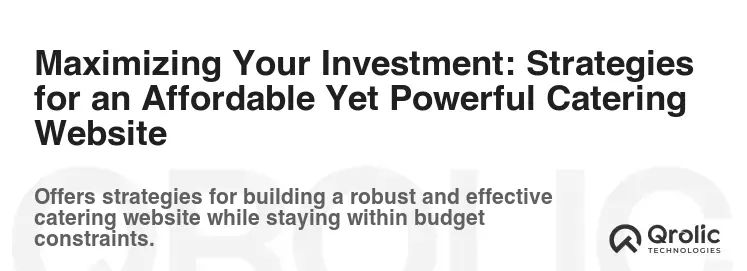
Navigating the various catering business website cost options can feel overwhelming. However, with smart planning and strategic choices, you can create a highly effective website without breaking the bank. The goal is value, not just lowest price.
A. Clear Planning & Goal Setting
Before you even think about design, define what you want your website to achieve.
- What are your primary goals? (e.g., generate 20 leads per month, increase online bookings by 30%, showcase luxury events).
- Who is your target audience? (e.g., corporate clients, wedding planners, small family gatherings).
- What is your unique selling proposition (USP)? A clear vision helps avoid scope creep, which is a major driver of increased cost to build catering website.
B. Prioritizing Features: Needs vs. Wants
Make a list of all desired features and categorize them:
- Must-Haves: Essential for launch and core functionality (e.g., responsive design, basic menu, contact form).
- Should-Haves: Important for a great user experience and conversion (e.g., online quote request, professional photos, blog).
- Could-Haves: Advanced features for future growth (e.g., CRM integration, loyalty program). Start with your “must-haves” and “should-haves” to manage the initial catering website budget. You can always add “could-haves” in later phases.
C. Smart Content Strategy: DIY vs. Professional
High-quality content (text, photos, video) is crucial.
- Photography: While professional photos are ideal, consider a single, high-quality photoshoot for your most popular dishes and event setups if budget is tight. Supplement with well-curated stock photos where appropriate. Don’t compromise on showing your food beautifully.
- Copywriting: If you’re a skilled writer, you can draft your own website copy. Otherwise, invest in a professional copywriter who understands SEO and can articulate your brand voice. Clear, compelling copy drives conversions.
D. Phased Development: Launching an MVP (Minimum Viable Product)
Instead of waiting to launch a fully-featured, complex site, consider a phased approach.
- Phase 1 (MVP): Launch with essential pages, key features, and professional branding. This allows you to get online, start collecting leads, and gather user feedback.
- Phase 2 & Beyond: Incrementally add more advanced features, expand content, and refine the design based on performance data and business growth. This spreads the catering business website cost over time.
E. Negotiating with Developers/Agencies
Don’t be afraid to ask for a detailed breakdown of costs and to negotiate.
- Get multiple quotes: Compare services, portfolios, and pricing from several agencies or freelancers.
- Understand payment terms: Ask about upfront deposits, milestone payments, and final payment schedules.
- Be clear about scope: Ambiguity leads to additional costs. A well-defined scope of work (SOW) protects both parties.
F. Leveraging Open-Source Solutions (where appropriate)
For Tier 2 websites, platforms like WordPress.org offer incredible power and flexibility at a lower licensing cost (free). The community support and vast plugin ecosystem can significantly reduce catering website development cost compared to proprietary systems, provided you have the technical expertise or a developer to manage it.
G. Understanding Maintenance Packages
Before you launch, understand what post-launch support and maintenance are included or available. A proactive maintenance plan ensures your site remains secure, fast, and up-to-date, preventing costly repairs down the line. Factor this into your affordable catering website solutions budget.
The “When” and “How”: The Development Process for Your Catering Website
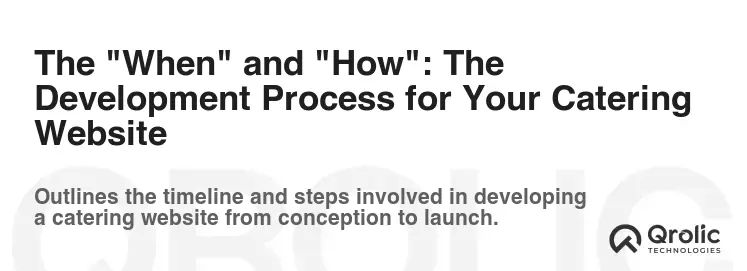
Building a professional catering website is a journey, not a single step. Understanding the typical phases of development helps manage expectations and ensures a smooth process, regardless of the final catering business website cost.
A. Phase 1: Discovery & Planning
- When: The very beginning.
- How: This is where you and your chosen web partner (developer or agency) define the project’s scope.
- Goal Setting: Reiterate your business objectives and website goals.
- Audience Analysis: Who are you trying to reach?
- Competitor Research: What are your rivals doing well (and poorly)?
- Feature Specification: Detailed list of all desired functionalities.
- Technology Stack: Deciding on the platform (WordPress, custom code, etc.).
- Sitemap Creation: Mapping out all the pages and their hierarchy.
- Budget & Timeline: Establishing a clear financial and time framework.
B. Phase 2: Design & Wireframing
- When: After planning is complete.
- How: This phase focuses on the visual and structural layout.
- Wireframes: Creating skeletal blueprints of pages to define layout and content placement without visual elements.
- Mockups/Prototypes: Developing static visual representations of key pages, incorporating branding, colors, typography, and imagery. This is your chance to see the “look and feel.”
- User Experience (UX) Design: Ensuring the site is intuitive, easy to navigate, and provides a seamless journey for your visitors.
- User Interface (UI) Design: Focusing on the aesthetics and interactivity of the site’s elements.
C. Phase 3: Development & Coding
- When: Once designs are approved.
- How: The actual building of the website.
- Front-End Development: Bringing the designs to life using HTML, CSS, and JavaScript. This is what users see and interact with.
- Back-End Development: Building the server-side logic, database, and integrating the CMS (e.g., WordPress). This powers the site’s functionality (online ordering, forms).
- Feature Integration: Connecting and configuring all specified functionalities.
- Database Setup: Structuring how your website stores information.
D. Phase 4: Content Integration & SEO Setup
- When: Can run concurrently with development or immediately after.
- How: Populating the website with your materials and optimizing for search engines.
- Content Upload: Adding all your text, images, videos, and menus to the website.
- SEO Optimization: Implementing on-page SEO elements (meta titles, descriptions, heading tags, image alt text), ensuring keyword density, setting up Google Analytics, and configuring schema markup.
- Internal Linking: Creating a logical link structure between your pages.
E. Phase 5: Testing & Launch
- When: Before the site goes live.
- How: Rigorous checks to ensure everything works perfectly.
- Functionality Testing: Checking all forms, buttons, links, and online ordering systems.
- Responsiveness Testing: Verifying the site looks and works flawlessly across all devices (desktops, tablets, mobile).
- Cross-Browser Compatibility: Ensuring consistent performance on different web browsers.
- Performance Testing: Checking page load speeds.
- Security Audit: Identifying and fixing any vulnerabilities.
- Client Review & Approval: Your final sign-off.
- Launch: Pushing the website live! This involves configuring domain name servers and conducting final checks.
F. Phase 6: Post-Launch Support & Marketing
- When: Immediately after launch and ongoing.
- How: The work doesn’t stop once the site is live.
- Monitoring: Tracking website performance, traffic, and user behavior using analytics tools.
- Maintenance: Regular updates, backups, and security checks.
- Bug Fixes: Addressing any issues that arise.
- SEO & Marketing: Ongoing efforts to drive traffic, improve rankings, and convert visitors into clients. This includes content marketing, social media promotion, and potentially paid advertising.
- Iterative Improvements: Based on analytics and user feedback, plan for future enhancements and feature additions.
Qrolic Technologies: Your Partner in Crafting an Exceptional Catering Website

Navigating the complexities of catering business website cost and development can be daunting. This is where Qrolic Technologies steps in as your trusted partner, transforming your digital aspirations into a tangible, high-performing asset. At Qrolic, we understand that a catering website isn’t just about code and design; it’s about translating your culinary artistry and business passion into an online experience that captivates and converts.
A. Who We Are and Our Vision
Qrolic Technologies is a leading Web Development and digital solutions provider, committed to empowering businesses with cutting-edge online presences. Our vision is to build more than just websites; we craft digital ecosystems that drive growth, enhance brand reputation, and streamline operations. We believe in innovation, transparency, and delivering measurable results. Our team combines technical prowess with creative flair, ensuring your website not only functions perfectly but also looks stunning and feels intuitive.
B. Our Expertise in the Food & Beverage Industry
We have extensive experience working with businesses in the food and beverage sector, giving us a unique insight into the specific needs and challenges of caterers. We understand the importance of:
- Visually Stunning Presentation: Food photography and videography integration that makes mouths water.
- Seamless Online Ordering & Booking: Intuitive systems that simplify the customer journey from inquiry to payment.
- Menu Flexibility: Dynamic menu displays that handle dietary restrictions, seasonal changes, and customizable packages.
- Brand Storytelling: Crafting compelling narratives that convey your passion and unique culinary identity.
- Local & Event SEO: optimizing your site to rank high for relevant local searches and event-specific queries, ensuring you’re found by the right clients at the right time.
C. How Qrolic Delivers Value for Your Catering Business
Choosing Qrolic means choosing a partner dedicated to your success, helping you navigate and optimize your catering website budget.
1. Custom Solutions Tailored to Your Brand
We don’t believe in one-size-fits-all. Our approach begins with a deep dive into your brand, your goals, and your target audience. Whether you’re a boutique caterer or a large event company, we design and develop a bespoke website that perfectly aligns with your unique identity and operational needs. We help clarify the catering business website cost based on YOUR specific requirements.
2. Focus on ROI and Business Growth
Every feature we implement, every design decision we make, is geared towards maximizing your return on investment. We build websites that are conversion-focused, designed to generate leads, increase bookings, and ultimately, grow your catering business. We understand that your website is a revenue-generating asset, not just an expense.
3. Comprehensive Service Offering (Design, Development, SEO, Maintenance)
From the initial concept and stunning graphic design to robust backend development, rigorous SEO optimization, and ongoing maintenance, Qrolic offers an end-to-end solution. This integrated approach ensures consistency, efficiency, and a seamless experience for you. You won’t have to juggle multiple vendors; we handle it all, providing clarity on every aspect of the website cost for caterers.
4. Transparent Pricing and Budgeting
We believe in complete transparency. Our detailed proposals clearly outline all expected catering business website cost components, ensuring you understand exactly where your investment is going. We work with you to find solutions that fit your budget while delivering exceptional quality and value.
D. Getting Started with Qrolic: A Simple Process
Embarking on your digital journey with Qrolic is straightforward:
- Initial Consultation: Reach out to us for a free, no-obligation discussion about your catering business, your vision, and your website needs.
- Detailed Proposal: Based on our conversation, we’ll craft a comprehensive proposal outlining our recommended strategy, features, timeline, and a clear breakdown of the catering business website cost.
- Collaborative Development: We work closely with you through every phase, from design mockups to content integration, ensuring your input shapes the final product.
- Launch & Support: After thorough testing, we launch your exceptional new website and provide ongoing support and maintenance to ensure its continued success.
Let Qrolic Technologies be the architect of your catering business’s digital triumph, building a website that truly reflects your culinary excellence and drives unparalleled success in 2026 and beyond.
Case Studies & Success Stories (Illustrative Examples)
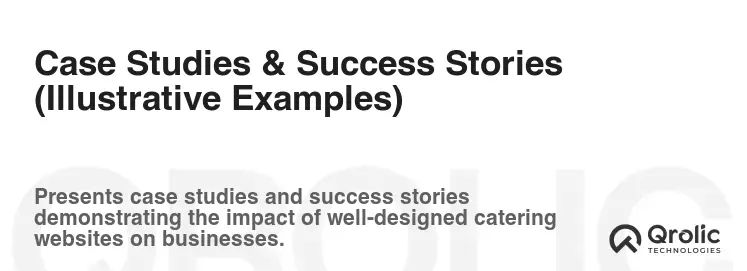
To truly grasp the impact of varying catering business website cost investments, let’s explore some illustrative scenarios. These aren’t just numbers; they represent tangible transformations for caterers like yours.
A. From Zero to Hero: A Small Caterer’s Journey (Tier 1 to Tier 2 Evolution)
- Caterer: “Tasteful Bites,” a solo entrepreneur specializing in small, private dinner parties and bespoke desserts. Initially relied solely on Instagram and word-of-mouth.
- Initial Need: A professional hub for inquiries, menu showcasing, and credibility.
- Solution (Phase 1 – Tier 1 Budget): Started with a Squarespace website.
- Cost: ~$350 annually (platform subscription + domain).
- Features: Elegant, mobile-responsive template; professional photos (DIY with a good camera and lighting); simple “Request a Quote” form; basic menu pages; contact info.
- Outcome: Within 6 months, inquiries doubled. Clients felt more confident, and the online presence allowed “Tasteful Bites” to gently raise prices due to perceived professionalism.
- Evolution (Phase 2 – Tier 2 Investment): After 18 months, realizing limitations of Squarespace for custom booking logic and advanced SEO, invested in a custom WordPress theme by a freelancer.
- Cost: ~$5,000 (development) + ~$300/year (hosting, premium plugins) + ~$1,000 (professional food photography refresh).
- Features: Integrated advanced inquiry form with specific event details; interactive menu builder; client testimonial section; blog for sharing culinary tips; improved local SEO.
- Outcome: Streamlined booking process reduced administrative time by 20%. Organic search traffic increased by 40%, leading to a 30% increase in high-value event bookings. The website paid for itself within the first year of the upgrade.
B. Scaling Up: How a Mid-Sized Caterer Expanded Reach (Tier 2 to Tier 3)
- Caterer: “City Harvest Catering,” an established firm handling corporate events, weddings, and large social gatherings, operating across a metropolitan area. They had a decent but slightly outdated WordPress Site.
- Initial Need: Enhance brand appeal, streamline complex booking processes, and integrate with existing CRM.
- Solution (Tier 2/3 Hybrid): Partnered with a mid-sized agency for a significant overhaul.
- Cost: ~$25,000 (custom design and development) + ~$1,500/year (cloud hosting, CRM integration fees, advanced plugin licenses). Also invested ~$3,000 in a comprehensive video portfolio and updated photography.
- Features: Bespoke, visually stunning design; sophisticated event planner tool (budget calculator, guest list manager); real-time availability checker for venues; seamless CRM integration for lead tracking; personalized client portals; advanced SEO strategy including schema markup for events.
- Outcome: Brand perception shifted towards luxury and innovation. Online quote requests became more detailed, reducing qualifying time. The integrated CRM led to a 15% improvement in conversion rates from inquiry to booking. Expanded into new service areas with targeted local SEO.
C. The Premium Experience: A Luxury Caterer’s Digital Transformation (Tier 3)
- Caterer: “Éclat Events & Cuisine,” a high-end catering service known for bespoke, Michelin-star level dining experiences for exclusive clientele and celebrity events. Their existing site didn’t convey their ultra-premium brand.
- Initial Need: A truly immersive, high-art digital experience that matched their unparalleled culinary and service quality, justifying their premium pricing.
- Solution (Full Tier 3 Custom Build): Engaged a high-end digital agency specializing in luxury brands.
- Cost: ~$60,000 (fully custom design, development, high-fidelity UX/UI) + ~$5,000/year (dedicated hosting, premium software, ongoing strategic SEO, advanced security). Also invested ~$10,000+ in multiple professional photoshoots, cinematic videography, and even drone footage of event setups.
- Features: Immersive full-screen video backgrounds; interactive 360-degree virtual tours of sample event setups; AI-powered personalized menu suggestions; integrated live chat with dedicated concierge; secure, bespoke client collaboration portal for event planning; multi-language support; robust security infrastructure.
- Outcome: The website became an extension of their luxury brand, attracting a higher caliber of client. Average contract value increased by 25%. The immersive experience significantly reduced the sales cycle, as clients felt they had a clear understanding of the ‘Éclat’ difference before even speaking with a representative. It solidified their position as a market leader in luxury catering.
These examples illustrate that while the catering business website cost can vary, the right investment at the right stage of your business’s growth yields significant, measurable returns.
Key Takeaways & Final Thoughts on Your Catering Website Investment
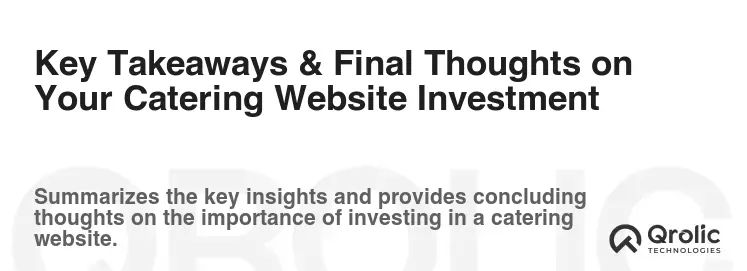
As we journey towards 2026, the digital storefront for your catering business is no longer a luxury but an absolute necessity. Understanding the catering business website cost is not just about crunching numbers; it’s about making a strategic investment in the future of your culinary enterprise.
A. Your Website as a Living Asset
Think of your website not as a one-time purchase, but as a dynamic, living asset that continually works for you. Like your best chef, it needs care, updates, and occasional refinements to perform at its peak. Embrace the ongoing costs of maintenance, content updates, and SEO as essential investments that fuel its performance and prolong its lifespan, ensuring it continues to bring in delightful new clients.
B. The Value of Expertise (Professional Help)
While DIY solutions offer a low entry point, the true power of a professional, conversion-focused catering website often comes from expert hands. Investing in a skilled web developer or agency, like Qrolic Technologies, means you benefit from:
- Strategic Planning: Avoiding costly mistakes by planning effectively from the start.
- Optimized Design: Creating an intuitive, visually appealing, and brand-consistent experience.
- Robust Functionality: Implementing reliable online ordering, booking, and management systems.
- Future-Proofing: Building on a scalable foundation that can grow with your business.
- SEO Excellence: Ensuring your website is easily discoverable by your target audience. The perceived high catering business website cost for professional help is often an investment in saved time, increased revenue, and peace of mind.
C. Planning for the Future
The digital landscape evolves at a breathtaking pace. When considering your catering website budget, always plan with scalability and future growth in mind. Choose a platform and a partner that can adapt your website to new technologies, expand its features as your business grows, and integrate seamlessly with future marketing efforts. Your website should be a spring board for innovation, not a static monument.
Your catering business pours passion and precision into every dish and every event. Your website deserves the same level of dedication. By thoughtfully assessing your needs, understanding the cost components, and choosing the right partners and strategies, you can build a digital presence that not only attracts but delights your clients, ensuring your catering business thrives in 2026 and for many years to come. The investment you make today in your catering business website cost will be the foundation for tomorrow’s success.
